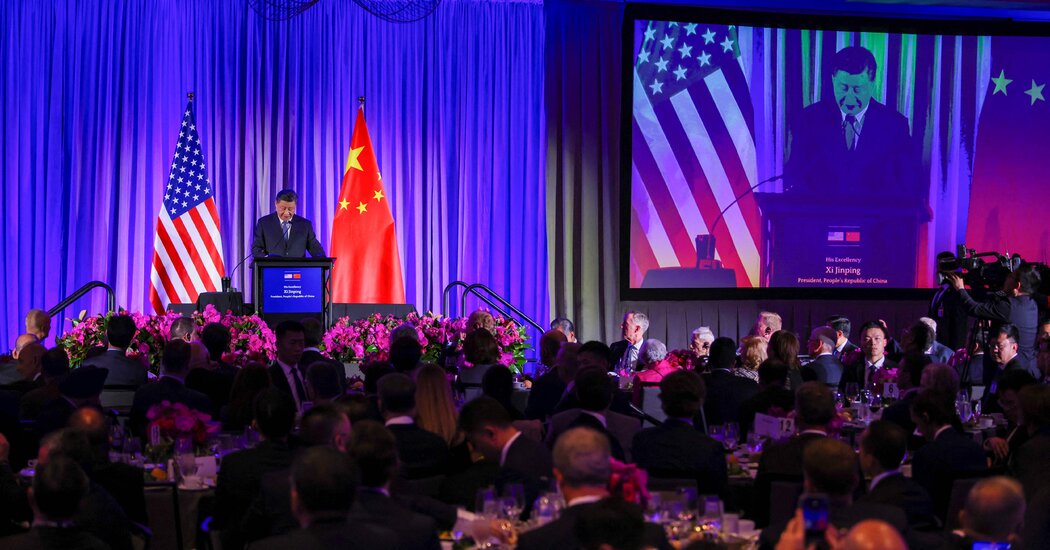Federal Reserve Officials See Rates Staying High
The era of ultralow interest rates may be over. At the very least, policymakers don’t expect the type of low borrowing costs that prevailed before the pandemic to return anytime soon.
The Federal Reserve decided this week to leave interest rates unchanged at their highest level in two decades, and left the door open to raising rates again before the end of the year. But an even more significant if subtle change lurked in their freshly released economic projections.
Fed officials do not expect rates to go much higher — the next quarter-point increase is likely to be the last, if they make even that. But they do expect borrowing costs to stay elevated for years to come. Policymakers expect their benchmark short-term interest rate to stay above 5 percent next year, and to end 2025 at nearly 4 percent, the estimates showed. That would be roughly double where they were at the end of 2019.
Even in 2026 — when, the Fed hopes, inflation will have been fully stamped out and economic growth will have settled back into its longer-run trend — policymakers expect rates to remain well above the levels that prevailed before the pandemic.
In other words, higher rates may be here to stay for years.
That conclusion stems in part from a simple observation: The Fed has raised interest rates aggressively over the past year and a half, yet the economy has barely blinked. That suggests that after years in which even the slightest increase in rates threatened to bring growth to a halt, the economy might at last be able to withstand higher borrowing costs.
“They are surprised at how strong the economy has been this year despite the large amount of tightening the Fed has done,” said Gabriel Chodorow-Reich, a professor of economics at Harvard, referring to Fed officials. The staying power suggests that rates may need to be higher to weigh on growth, and that “Fed policy hasn’t been quite as tight as we thought it was.”
On Wall Street, analysts have begun summing up the Fed’s new worldview in a simple phrase: “Higher for longer.”
A new era of higher rates would be significant development for many households, especially would-be home buyers dreaming of the return of 3 percent mortgage rates.
The Fed’s rate setting trickles through the rest of the economy to make it more expensive to borrow to pay for a car, a house or a business expansion. Mortgage rates, for example, are above 7 percent, up sharply from a low of about 2.7 percent before the Fed’s rate moves started.
High rates could also be bad news for sophisticated investors who were raking in big profits by making bets using borrowed cash during the “free money” era that preceded the pandemic. And they could cause problems for borrowers who have big outstanding debt piles that could now reset at higher interest rates — an issue facing both commercial real estate companies and the United States government, which is spending steadily more just to pay interest on its debt.
Investors reacted to the Fed’s higher-for-longer prediction glumly. The S&P 500 stock index slumped over 1 percent on Thursday morning, adding to similar losses on Wednesday. Higher interest rates raise costs for consumers and companies. The longer that interest rates remain high, the more those costs rack up, eroding corporate profitability.
It appeared the Fed’s message sank in elsewhere in markets, too. Measures of interest rates rose sharply, as did investors’ bets on where interest rates will be in the future.
But for the economy as a whole, higher rates could bring some welcome changes.
The Fed’s tools for managing the economy didn’t work as well in a low-rate world. Officials struggled to boost the economy enough in the years after the 2007 to 2009 recession as even near-zero rates failed to entice borrowers and spur lots of spending. The recovery muddled along at a tepid pace for years. If rates have reset to higher levels, that could make it easier to stimulate growth in times of economic trouble.
Higher rates could also be good news for savers, who were for years forced to take bigger risks with their cash if they wanted to earn a decent return.
Of course, the Fed’s rate predictions may not come true.
Economic forecasts are notoriously unreliable, especially in the longer run — a point Jerome H. Powell, the Fed chair, made repeatedly on Wednesday. If the economic recovery stalls out in coming months and unemployment soars, policymakers could find themselves forced to cut rates more than they currently anticipate.
And even if rates do stay high, there are big questions about whether that change lasts a few years, as the Fed currently predicts, or marks a more permanent shift.
For now, policymakers are forecasting that the pop in interest rates will eventually fade. They kept their estimate of the rate setting that will keep the economy chugging along at a steady and sustainable pace in the longer run — something economists often call the “neutral rate” — unchanged in their projections, at 2.5 percent.
Asked on Wednesday why Fed officials expect rates to remain higher through 2026, Mr. Powell pointed to recent strong economic activity, which he said generally suggests “we have to do more with rates.”
But the Fed chair was not yet ready to conclude that the economy has undergone a lasting shift.
“It may of course be that the neutral rate has risen,” Mr. Powell said. “You do see people raising their estimates.”
Seven of the Fed’s 19 policymakers on Wednesday predicted that rates could hover above 2.5 percent in the longer run — the same number as in the last set of forecasts, in June. But four officials said they expected interest rates to settle above 3 percent in the long term, up from two members in June and zero a year ago.
Whether rates are temporarily or permanently elevated matters. If the interest rate that the economy can handle without slowing down has permanently increased, it would take higher borrowing costs to cool the economy if it begins to overheat.
That may sound complicated, but the logic is fairly simple: If people expect to pay 3.75 percent interest to get their hands on cash during normal times, then a 5.25 percent rate might scare some of them off. But that same 5.25 percent rate will be a much bigger obstacle if people have built their business models and household finances around a 2.5 percent interest rate world. It could be the difference between tapping the brakes and slamming the pedal to the floor.
Changes in the neutral rate are tough to spot in real time. Many drivers help determine what interest rate the economy can handle: Demographics, government indebtedness, corporate expansion plans and inequality can all push rates up or down.
Economists have models to try to predict the neutral rate, but in practice, they watch to see how growth is reacting to rate moves.
“We know it by its works — we only know it by its works,” Mr. Powell said on Wednesday.
Some economists argue that the neutral rate might have moved temporarily higher in the aftermath of the pandemic, but are skeptical of a longer-run shift. Big economic trends, such as aging populations and high inequality, have not fundamentally changed.
“I don’t think we have a compelling reason to believe” that rates will be higher, said Gauti Eggertsson, an economics professor at Brown University.
Still, a growing number of economists do think that rates are likely to be permanently higher. Huge government debt piles have ramped up demand for borrowed money, for one thing.
“There’s just a growing imbalance between tax revenues coming in and spending going out,” said Joseph H. Davis, global chief economist at Vanguard. As a result, he added, “longer term, interest rates are not always going to show that pull toward” zero.
There are also more optimistic theories. Daleep Singh, a former Biden administration and New York Fed official now at PGIM Fixed Income, pointed to investments in green energy and new technologies like artificial intelligence as trends that could push both growth and rates higher.
“I think that they did everything but raise the long-term neutral rate,” Mr. Singh said of the Fed.
Joe Rennison contributed reporting.


